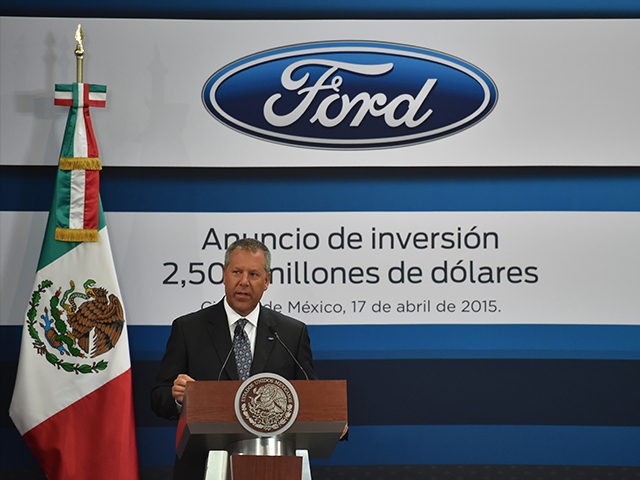Ford Motor Company made headlines on Wednesday, September 9, when CEO Mark Fields announced that it will invest $1.6 billion building a manufacturing plant in Mexico and will move all of its small car production there.
Ford has been talking about the shift for more than a year. But in the throes of an election, the decision was an invitation for attention. The next day, during a speech in Flint, Michigan, Donald Trump declared that it was: “horrible.” He’s previously promised to punish Ford with a 35 percent tariff on cars made in Mexico that are then sold in America.
No one wants American jobs to go away—and Ford plans to build more profitable vehicles in the plants that currently produce the Focus and C-Max small cars. It claims it is not going anywhere and that the U.S. is its home. Reports do indicate that no jobs at the Wayne, Michigan, plant will be lost, as it will likely be converted to building the new mid-size Ranger pick-up truck and, possibly, a new Bronco compact sport-utility.
But there’s more to the story that isn’t generally being addressed.
Earlier this year, Fields told CNBC: “We’re always going to invest where it makes sense for business.”
Obviously, it no longer makes “sense” to invest in small car production in America. Most of the news surrounding the move to Mexico addressed the benefit of low-cost labor. According to the Detroit Free Press: “The industry has known for decades that domestic manufacturers struggle to make a profit on small cars.”
By subscribing, you agree to our terms of use & privacy policy. You will receive email marketing messages from Breitbart News Network to the email you provide. You may unsubscribe at any time.
The number of auto jobs in Mexico is up 40 percent from 2008, while they are only up in the U.S. by 15 percent over the same period. Reuters reports: “American automakers pay Mexican workers $8 to 10 an hour, including benefits.” By comparison, Ford’s labor costs average $57 per hour at home.
Even with the huge labor cost differential, American companies’ trucks and SUVs are profitable to manufacture in the U.S. and they are the vehicles Americans want to buy—which should raise the question: Why do car companies make small cars when they can’t make them profitably? The answer is the story not being addressed in the current coverage of Ford. And this is where Trump could, possibly, change the outcome.
In a free-market world, companies that want to stay in business stop activities that lose money and focus on those that make money. Yet, the big three automakers, continue to produce small cars that for years have made little, if any, money.
Business Insider explains: “If Ford is going to keep them around, it needs to address the profit problem. Americans don’t want to buy small vehicles at the moment (actually, they almost never want to buy small cars), so Ford’s only rationale for continuing to build them is to satisfy the more stringent fuel-economy standards in the future.” Those fuel standards are called CAFE—which stands for Corporate Average Fuel Economy. In short, it means that car companies can only sell the bigger vehicles that Americans want, if it also produces cars that achieve very high fuel efficiency (including electric vehicles, in which Ford is investing heavily) that results in an “average” of the mandated miles per gallon—which is now 54.5 by 2025.
Merrill Matthews, Ph.D., a resident scholar with the Institute for Policy Innovation, blames the Ford move on, along with other draconian government policies, the CAFE standards: “The CAFE standards, which began in 1975, require auto manufacturers to meet government-imposed fuel economy standards across a fleet of cars. In order to meet those standards, which have been dramatically increased under President Obama, carmakers have to make light, inexpensive cars with high fuel economy to offset their trucks and SUVs with lower fuel economy. And electric cars really help their fuel economy balance. So the companies make minimally or even unprofitable small cars and electric vehicles so they can sell their popular and profitable large products—and hope for a profit in the end. By moving their small cars to Mexico, which has skilled but cheaper labor, Ford hopes to break even or make a little profit off of them.”
While the CAFE standards have increased dramatically under the Obama administration, and have also increased costs for consumers, most people don’t realize that they are not set in stone. Brad Plumer, senior editor for VOX.com outlines the options: “A new president can revise them, up or down. These CAFE (corporate average fuel economy) rules are scheduled to come up for a midterm review in 2017. At that point, automakers may lobby to allow the standards to rise more slowly—particularly if sales of fuel-efficient vehicles have been sluggish due to low oil prices. Green groups, meanwhile, could push to make the standards stricter, or to have them keep increasing past 2025, to push vehicle emissions down even further.”
A President Trump could, perhaps, by promising to allow car companies to make whatever kind of cars they want to make, entice Ford to keep its money in America—though, admittedly, CAFE is just one of the many policies that make doing business difficult in America.
Revising the CAFE standards is something Trump can do that would make doing business in America “make sense” again for U.S. car companies. For all business, let’s make America a place where it makes sense to invest.
The author of Energy Freedom, Marita Noon serves as the executive director for Energy Makes America Great Inc., and the companion educational organization, the Citizens’ Alliance for Responsible Energy (CARE). She hosts a weekly radio program: America’s Voice for Energy—which expands on the content of her weekly column. Follow her @EnergyRabbit.



COMMENTS
Please let us know if you're having issues with commenting.